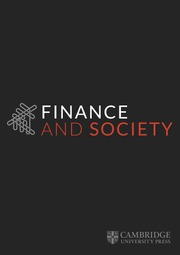No CrossRef data available.
Article contents
Edges of the financial imagination
Published online by Cambridge University Press: 09 November 2023
Extract
Core share and HTML view are not available for this content. However, as you have access to this content, a full PDF is available via the ‘Save PDF’ action button.
Neither external nor internal to finance, the financial imagination marks out a space where the theoretical and practical aspects of finance come together in the inner life of the subject. That means there is something about financial subjectivity that escapes a functional view on the imagination. The purpose of this forum is to probe the contours of the financial imagination in terms of its perimeters and blind spots, its fantasies and delusions.
- Type
- Forum: Edges of the financial imagination
- Information
- Creative Commons
- This is an Open Access article, distributed under the terms of the Creative Commons Attribution-NonCommercial-No Derivatives licence (http://creativecommons.org/licenses/by-nc-nd/4.0/), which permits noncommercial re-use, distribution, and reproduction in any medium, provided the original work is unaltered and is properly cited. The written permission of Cambridge University Press must be obtained for commercial re-use or in order to create a derivative work.
- Copyright
- © 2023 The Author(s)
References
Aitken, R. (2020) “A machine for living”:
The cultural economy of financial subjectivity. In: Mader, P., Mertens, D. and Van der Zwan, N. (eds.) The Routledge International Handbook of
Financialization.
London:
Routledge, 369–79.Google Scholar
Bennett, D. (ed.) (2012) Loaded Subjects: Psychoanalysis, Money
and the Global Financial Crisis.
London: Lawrence and
Wishart.Google Scholar
Biltoft, C. (2023) Eros and the nature of
‘interest’. Finance and
Society, 9(1):
61–64.10.2218/finsoc.8095CrossRefGoogle Scholar
Brown, W. (2015) Undoing the Demos: Neoliberalism's
Stealth Revolution.
New York: Zone
Books.CrossRefGoogle Scholar
Callon, M. (2007) What does it mean to say that
economics is performative? In: MacKenzie, D., Muniesa, F. and Siu, L. (eds.) Do Economists Make Markets? On the Performativity of
Economics.
Princeton, NJ: Princeton
University Press, 311–57.Google Scholar
Commons, J.R. (1934) Institutional Economics: Its Place in
Political Economy, Vols. I-I.
New Brunswick, NJ: Transaction
Publishers.Google Scholar
De Goede, M. (2005) Virtue, Fortune, and Faith: A Genealogy of
Finance.
Minneapolis: University of
Minnesota Press.Google Scholar
Deleuze, G. and Guattari, F. (1983) Anti-Oedipus: Capitalism and
Schizophrenia.
Minneapolis: University of
Minnesota Press.Google Scholar
Downey, L. and Eich, S. (2023) Crypto-politics and counterfeit
democracy. Finance and Society,
9(1):
69–72.10.2218/finsoc.8097CrossRefGoogle Scholar
Esposito, E. (2011) The Future of Futures: The Time of Money in
Financing and Society.
Aldershot: Edward
Elgar.10.4337/9781849809115CrossRefGoogle Scholar
Feher, M. (2018) Rated Agency: Investee Politics in a
Speculative Age.
New York: Zone
Books.Google Scholar
Haiven, M. (2014) Cultures of Financialization: Fictitious
Capital in Popular Culture and Everyday Life.
Basingtoke: Palgrave
Macmillan.10.1057/9781137355973CrossRefGoogle Scholar
Juárez, G. (2023) Freeze to defrost! Negating the asset
form. Finance and Society,
9(1):
84–88.10.2218/finsoc.8101CrossRefGoogle Scholar
Konings, M. (2023) Imagining the future in bailout
capitalism. Finance and Society,
9(1)
80–83.10.2218/finsoc.8100CrossRefGoogle Scholar
MacKenzie, D. (2006) An Engine, Not a Camera: How Financial
Models Shape Markets.
Cambridge, MA: MIT
Press.10.7551/mitpress/9780262134606.001.0001CrossRefGoogle Scholar
Martin, R. (2002) Financialization of Daily Life.
Philadelphia, PA: Temple
University Press.Google Scholar
Mehrling, P. (2005) Fischer Black and the Revolutionary Idea of
Finance.
Hoboken, NJ: John Wiley &
Sons.Google Scholar
Muniesa, F. (2023) Revaluation fantasy.
Finance and Society, 9(1):
73–75.10.2218/finsoc.8098CrossRefGoogle Scholar
Poovey, M. (2008) Genres of the Credit Economy: Mediating
Value in Eighteenth- and Nineteenth-Century Britain.
Chicago, IL: University of
Chicago Press.10.7208/chicago/9780226675213.001.0001CrossRefGoogle Scholar
Samman, A. (2023) The void in finance.
Finance and Society, 9(1):
58–60.10.2218/finsoc.8093CrossRefGoogle Scholar
Samman, A. and Gammon, E. (eds.) (2023) Clickbait Capitalism: Economies of
Desire in the Twenty-First Century.
Manchester: Manchester University
Press.10.7765/9781526168177CrossRefGoogle Scholar
Santner, E.L. (2016) The Weight of All Flesh: On the
Subject-Matter of Political Economy.
Oxford: Oxford University
Press.10.1093/acprof:oso/9780190254087.001.0001CrossRefGoogle Scholar
Toporowski, J. (2005) Theories of Financial Disturbance: An
Examination of Critical Theories of Finance from Adam Smith to the Present
Day.
Cheltenham: Edward
Elgar.10.4337/9781845425739CrossRefGoogle Scholar
Vighi, F. (2023) Financial delusions and the
persistence of capital. Finance and
Society, 9(1):
76–79.10.2218/finsoc.8099CrossRefGoogle Scholar
Vogl, J. (2021) Capital and ressentiment: The
totalizing power of social fragmentation. Finance
and Society, 7(2):
140–45.10.2218/finsoc.v7i2.6632CrossRefGoogle Scholar
Zieger, S. (2023) Fake goods.
Finance and Society, 9(1):
65–68.10.2218/finsoc.8096CrossRefGoogle Scholar


